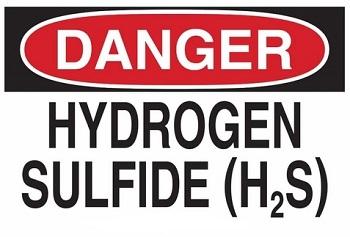Hydrogen Sulfide (H2S) is a toxic gas that is commonly found in industrial environments such as oil and gas production, wastewater treatment, and other industries. It is important to understand the potential dangers of hydrogen sulfide and how to protect yourself and your employees from exposure. According to the Occupational Safety and Health Administration (OSHA), exposure to high levels of hydrogen sulfide can result in serious health effects, including death.
According to the U.S. Bureau of Labor Statistics (BLS), inhaling hydrogen sulfide lead to 46 fatal injuries between 2011 and 2017.
To protect yourself and your employees from exposure to hydrogen sulfide, it is crucial to understand the properties of the gas, evaluate the risk of exposure, use appropriate personal protective equipment, implement a monitoring program, provide training and education, establish emergency procedures, use proper ventilation, and ensure that emergency response teams are prepared.
To help keep you and your employees safe from the potential dangers of hydrogen sulfide, I am going to share 10 essential safety tips. By following these tips, you can take the necessary steps to prevent accidents and injuries caused by hydrogen sulfide exposure in the workplace:
- Understand the properties of hydrogen sulfide: Hydrogen sulfide is a colorless gas that has a strong, rotten egg odor. It is heavier than air and can accumulate in low-lying areas. It is flammable and explosive in high concentrations. It is important to understand the properties of hydrogen sulfide so that you can recognize the potential hazards. By understanding the properties of the gas, you can better anticipate the potential risks and take appropriate precautions. This includes knowing the warning signs of exposure such as the smell of rotten eggs and being familiar with the symptoms of exposure such as headaches, nausea, and difficulty breathing.
- Evaluate the risk of exposure: Before beginning work in an area where hydrogen sulfide may be present, it is important to evaluate the risk of exposure. This includes identifying the sources of hydrogen sulfide, the concentration levels, and the potential exposure routes. By evaluating the risk of exposure, you can determine the appropriate safety precautions and controls that need to be put in place to protect yourself and your employees. This includes determining the appropriate PPE, implementing a monitoring program, and developing emergency procedures.
- Use appropriate personal protective equipment: When working in an area where hydrogen sulfide may be present, it is important to use appropriate personal protective equipment. This includes a gas mask or respirator, protective clothing, and eye protection. PPE is a crucial component in reducing the risk of exposure to hydrogen sulfide. It is important to ensure that the PPE used is appropriate for the specific task and that it fits properly and is well maintained. Employees should be properly trained on how to use the PPE, and it should be inspected before each use to ensure it is in good working order.
- Implement a monitoring program: To ensure that hydrogen sulfide levels are being effectively controlled, it is important to implement a monitoring program. This includes regular testing of the air to measure hydrogen sulfide concentrations and taking steps to correct any issues that are identified. A monitoring program will help ensure that the work area is safe and that the appropriate controls are in place. This includes regular air quality monitoring and ensuring that alarms and warning systems are functioning properly.
- Provide training and education: It is important to provide training and education to employees who may be exposed to hydrogen sulfide. This includes information on the properties of hydrogen sulfide, the potential hazards, and the appropriate safety precautions. Training and education are crucial in ensuring that employees are aware of the risks and know how to protect themselves. This should be done on an ongoing basis to ensure that employees are up-to-date on the latest information and best practices.
- Establish emergency procedures: In the event of an emergency involving hydrogen sulfide, it is important to have established procedures in place. This includes evacuation plans, emergency response procedures, and procedures for shutting down equipment. These procedures should be clearly communicated to all employees and practiced regularly. This will help ensure that everyone knows what to do in case of an emergency and that the appropriate actions can be taken quickly to minimize the risk of injury or harm.
- Use proper ventilation: Proper ventilation is crucial in reducing the risk of exposure to hydrogen sulfide. This includes using exhaust fans, ventilation systems, and other equipment to ensure that the air is being properly circulated and that hydrogen sulfide levels are being effectively controlled. Proper ventilation is an essential component in reducing the risk of exposure to hydrogen sulfide. This includes ensuring that ventilation systems are functioning properly and that the work area is well ventilated.
- Use the right tools: When working in an area where hydrogen sulfide may be present, it is important to use the right tools. This includes using hydrogen sulfide detection equipment, such as gas detectors, to measure the levels of hydrogen sulfide in the air. Using the right tools is essential in ensuring that hydrogen sulfide levels are being effectively controlled. It is important to ensure that gas detectors are functioning properly and that employees are trained on how to use them.
- Follow OSHA standards: OSHA has established standards for hydrogen sulfide, including guidelines for evaluating and controlling exposure. It is important to follow these standards to ensure that you are taking the appropriate safety precautions. OSHA standards provide a framework for protecting workers from the hazards of hydrogen sulfide and it is important to be aware of these standards and to comply with them.
- Regularly review and update procedures: Finally, it is important to regularly review and update your procedures for working with hydrogen sulfide. This includes reviewing and updating your emergency procedures, monitoring program, and training and education program. By regularly reviewing and updating these procedures, you can ensure that they are up-to-date and effective in protecting workers from the hazards of hydrogen sulfide. Regularly reviewing and updating procedures also helps to identify and address any issues that may arise over time.
In conclusion, hydrogen sulfide can be a dangerous gas to work with and it is important to take appropriate precautions to protect yourself and your employees. By following these top 10 hydrogen sulfide safety tips, you can help ensure that your work environment is safe and that you are taking the necessary steps to reduce the risk of exposure to hydrogen sulfide. Remember to stay informed and aware of the latest information and best practices for working with hydrogen sulfide.
References:










